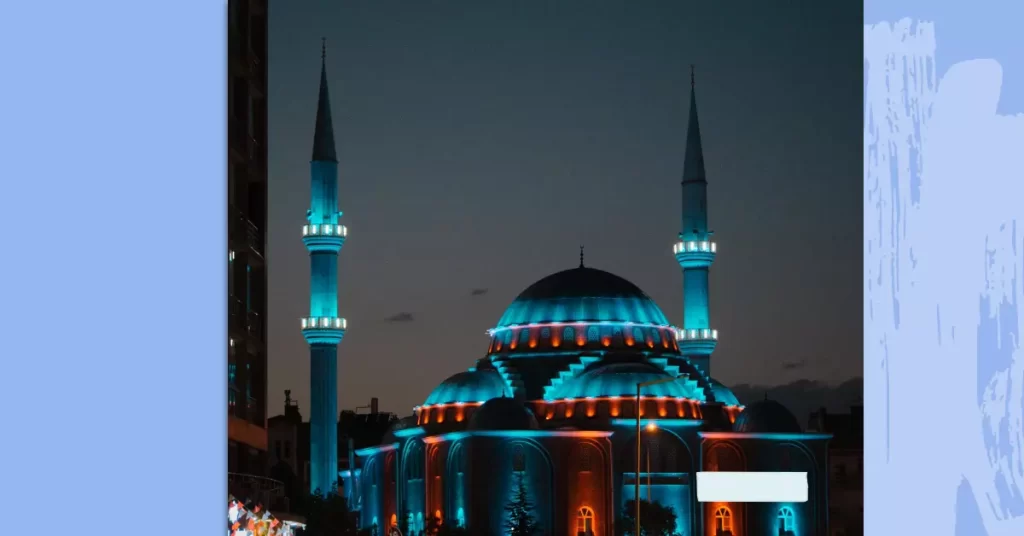
Islamic architecture stands as a testament to the rich cultural heritage of the Muslim world. From magnificent mosques to intricately designed palaces, the architectural wonders created by Islamic civilizations have left an indelible mark on the world.
For Muslim travelers seeking a deeper connection with their faith and a journey that blends history, art, and spirituality, this blog post offers a curated list of inspiring destinations to explore. Join us as we embark on a captivating journey through the remarkable Islamic architectural marvels, uncovering their significance and beauty, and discovering the spiritual essence they embody.
From the awe-inspiring Hagia Sophia in Istanbul to the majestic Sheikh Zayed Grand Mosque in Abu Dhabi, prepare to be mesmerized by the architectural splendors that await you on this immersive exploration of Islamic architecture.
The significance of Islamic architecture
Islamic architecture holds a rich and significant history that spans across centuries and continents. This architectural style is not merely about creating beautiful structures but is deeply rooted in the religious and cultural beliefs of the Muslim community.
From intricate geometric patterns to stunning domes and minarets, Islamic architecture showcases the devotion and creativity of the Muslim world. One of the key features of Islamic architecture is its emphasis on spirituality.
Mosques, the primary religious gathering places for Muslims, are architectural masterpieces that reflect the devotion and connection to the divine. The design of a mosque is carefully planned to create a tranquil and welcoming atmosphere for worshippers.
From the grandeur of the Sultan Ahmed Mosque in Istanbul to the serene beauty of the Sheikh Zayed Grand Mosque in Abu Dhabi, these sacred spaces not only serve as places of worship but also inspire awe and reverence. Islamic architecture is also characterized by its intricate ornamentation and geometric patterns.
These patterns, known as arabesques, are often seen on domes, walls, and ceilings of Islamic buildings. They are not just decorative elements but carry symbolic meanings. The repetition of geometric shapes represents the infinite nature of God, while the intricate craftsmanship showcases the skill and dedication of the artisans.
Moreover, Islamic architecture is known for its harmonious integration with nature. Many Islamic buildings feature gardens, courtyards, and water elements, creating a sense of tranquility and connecting the human spirit with the natural world. The Alhambra in Granada, Spain, with its stunning courtyards adorned with fountains and lush greenery, is a prime example of this integration.
Islamic architecture is not confined to a specific region but can be found across the globe. From the iconic structures of the Middle East to the stunning mosques in Southeast Asia, each destination offers a unique perspective on Islamic architectural styles and influences.
Exploring these destinations allows Muslim travelers to appreciate the historical, cultural, and spiritual significance of Islamic architecture while experiencing the beauty and serenity it brings.
Islamic architecture is a testament to the rich heritage and cultural identity of the Muslim community. Its significance goes beyond mere aesthetics, as it encapsulates the spiritual connection, artistic craftsmanship, and integration with nature.
Exploring the world of Islamic architecture is an inspiring journey that allows Muslim travelers to connect with their roots, appreciate the beauty of their faith, and experience the architectural wonders created by their ancestors.
The iconic architectural wonders of Istanbul
Istanbul, the bridge between two continents, is a city known for its rich history and stunning architectural wonders. For Muslim travelers, this vibrant city offers a plethora of iconic landmarks that showcase the beauty of Islamic architecture.

One of the most famous sites in Istanbul is the Hagia Sophia, a breathtaking masterpiece that has stood the test of time. Originally built as a Christian basilica, it was later converted into a mosque and now serves as a museum. Its grand dome, intricate mosaics, and towering minarets are a testament to the blending of Byzantine and Ottoman architectural styles.
Another must-visit destination is the Blue Mosque, officially known as the Sultan Ahmed Mosque. With its striking blue tiles, cascading domes, and six minarets, this architectural gem is an awe-inspiring sight. Step inside to experience the tranquility of the prayer hall, adorned with delicate calligraphy and beautiful stained glass windows.
For those seeking a unique architectural experience, the Süleymaniye Mosque is a hidden gem. Designed by the famous Ottoman architect Mimar Sinan, this mosque stands proudly on a hilltop, offering panoramic views of the city. Its elegant domes, intricate interiors, and peaceful courtyards make it a true masterpiece of Islamic architecture.
Lastly, a visit to the Topkapi Palace is a journey back in time. Once the residence of Ottoman sultans, this sprawling complex showcases a blend of Byzantine, Islamic, and Ottoman architectural styles. Explore its ornate courtyards, opulent halls, and stunning gardens, and immerse yourself in the grandeur of the Ottoman Empire.
As you stroll through the streets of Istanbul, you’ll encounter countless other architectural gems, from historic mosques and medreses to charming Ottoman houses. Each structure tells a story, a reflection of Istanbul’s rich cultural heritage and the imprint of Islamic architectural traditions.
Whether you’re a history enthusiast or simply in awe of beautiful architecture, exploring the iconic wonders of Istanbul is a journey that will leave a lasting impression on any Muslim traveler.
Exploring the architectural gems of the Middle East
The Middle East is a treasure trove of architectural marvels, with its rich history and deep-rooted Islamic heritage. Muslim travelers seeking to embark on a journey through Islamic architecture will find themselves captivated by the stunning destinations that await them. From majestic mosques to intricately designed palaces, the Middle East offers a truly awe-inspiring experience.
One cannot begin to explore Islamic architecture without mentioning the iconic structures of Saudi Arabia. The Masjid al-Haram in Mecca, the holiest site in Islam, stands as a testament to the faith and devotion of millions of Muslims around the world. Its grandeur and sheer size are awe-inspiring, making it a must-visit destination for any Muslim traveler.
Moving on to the United Arab Emirates, the Sheikh Zayed Grand Mosque in Abu Dhabi is a sight to behold. Its pristine white marble facade, adorned with intricate floral designs and calligraphy, creates a sense of tranquility and serenity. Inside, the sheer opulence and attention to detail will leave visitors breathless.
No journey through Islamic architecture is complete without a visit to Iran. The Nasir al-Mulk Mosque in Shiraz, also known as the Pink Mosque, is a masterpiece of Persian architecture. Its stained glass windows, kaleidoscope of colors, and intricate tilework create a mesmerizing play of light and shadow, an experience that is nothing short of enchanting.
Venturing into Turkey, the Hagia Sophia in Istanbul stands as a symbol of the intersection of Islamic and Byzantine architecture. Its domed ceiling, adorned with intricate mosaics and calligraphy, is a testament to the rich history and cultural heritage of this transcontinental city.
These are just a few examples of the architectural gems that await Muslim travelers in the Middle East. From the ancient wonders of Egypt to the modern masterpieces of Qatar, the region is a tapestry of Islamic artistry and innovation.
Whether you are a history enthusiast, an art lover, or simply seeking spiritual enlightenment, a journey through Islamic architecture in the Middle East will leave you inspired and in awe of the beauty that lies within these cultural treasures.
Unveiling the hidden treasures of North Africa
As Muslim travelers, we are always on the lookout for destinations that not only offer breathtaking sights but also hold deep historical and cultural significance. One such region that must be on our travel radar is North Africa, a treasure trove of Islamic architecture. From the stunning palaces of Morocco to the majestic mosques of Tunisia and the ancient ruins of Algeria, North Africa offers a journey through time and an opportunity to witness the grandeur of Islamic architecture.
In Morocco, a visit to the iconic Hassan II Mosque in Casablanca is a must. This architectural marvel, with its intricate details and breathtaking ocean views, is a true testament to the craftsmanship of Islamic artisans. Another gem in Morocco is the historic city of Fez, known for its well-preserved medina and beautiful mosques such as the Al-Qarawiyyin Mosque, one of the oldest universities in the world.
Moving east, Tunisia boasts architectural wonders like the Great Mosque of Kairouan, a UNESCO World Heritage site. Its minaret, dating back to the 9th century, is considered a masterpiece of Islamic art. The city of Sidi Bou Said is another gem, with its blue and white buildings and stunning views of the Mediterranean Sea.
Algeria, with its rich history and diverse landscapes, also offers remarkable architectural treasures. The ancient city of Tlemcen, known as the “Pearl of the West,” is home to the grand Mosque of Sidi Boumediene, an architectural masterpiece blending Islamic and Andalusian styles. The UNESCO-listed Casbah of Algiers is another must-visit, offering a glimpse into the country’s historical and cultural heritage.
Exploring the hidden treasures of North Africa allows Muslim travelers to immerse themselves in the rich Islamic heritage of the region. Whether it’s marveling at the intricate tile work, admiring the soaring minarets, or simply being in awe of the centuries-old craftsmanship, these destinations offer a truly inspiring journey through Islamic architecture.


